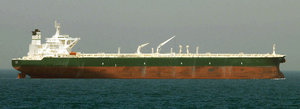Supertanker
|
|
A supertanker is a tanker ship built to transport very large quantities of liquids, especially crude oil. The terms VLCC (Very-Large Crude Carrier) and ULCC (Ultra-Large Crude Carrier) are also sometimes used.
Tanker ships above 250,000 metric tons are generally considered supertankers. They are the largest ships in the world, larger even than aircraft carriers. When first introduced their size and draft prevented them from docking at many existing docks, requiring them to discharge their cargo into smaller tankers offshore. Some ports have developed special deep-water off-loading facilities connected to the land by pipelines.
Due to their size and mass, supertankers have very poor maneuverability; the stopping distance of a supertanker is typically measured in miles. When operating close to the shoreline they are vulnerable to running aground, whether due to mechanical failure, human error or bad weather. When this happens oil spills are a significant risk. A laden supertanker can carry millions of gallons of oil, which can pollute many miles of coastline. In "single-hulled" tankers, the hull is also the wall of the oil tanks, and any breach will result in an oil spill. Newer tankers are "double-hulled", with an air space between the hull and the storage tanks, to reduce the risk of a spill in the event that the hull is breached.
Following the Exxon Valdez incident, the United States mandated in the Oil Pollution Act of 1990 (OPA-90) that all supertankers entering United States waters be double-hulled by 2015. The European Union has similar legislation requiring all tankers entering their waters to be double-hulled by 2010.

